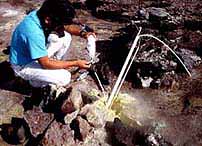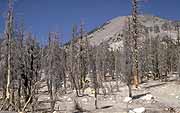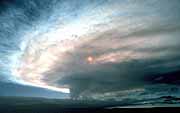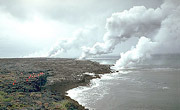
Other than free oxygen, generated by photosynthesis, all atmospheric gases were derived from inside the earth and released by volcanic eruptions. The gaseous portion of magma varies from ~1 to 5% of the total weight. Water vapor constitutes 70-90%. The remaining gases include CO2, SO2, and trace amounts of of N, H, CO, S, Ar, Cl, and F. These subordinate gases can combine with hydrogen and water to produce numerous toxic compounds, such as HCl, HF, H2SO4, H2S, which are typical products of fumarolic activity.
| MAIN GASES | TRACE GASES | TOXIC GASES |
|
H2O (70-90%) CO2 SO2 |
N, H, S, F, Ar, CO, Cl |
HCl, HF H2SO4 H2S |
A variety of sulfur aerosols may be present and sulfur itself may condenses around the fumarole into a crystalline accumulation called sulfaterra (yellow ground). On some volcanoes, enough sulfur is present to be mined as an economic resource. H2S is sometimes called "sewer gas" because it has a rotten egg odor. It is an insidious poison that irritates the eyes, nose, and throat. SO2 on the other hand, is the biting, chocking gas that you smell right after you've lit a kitchen match. When these two gases occur together, they react quickly with each other (within minutes) to produce sulfaterra and water vapor.
Monitoring volcanic gases can be helpful in predicting eruptions. For example, an increase in CO2 and SO2 concentrations emitted from fumaroles may indicate increasing magmatic activity beneath the volcano. The composition and relative volumes of these volatiles can be measured in a variety of ways:

|

|
|
in an evacuated flask. Courtesy of the USGS |
on Mt. St. Helens. Courtesy of the USGS |
The destructive effects of volcanism are usually attributed to voluminous outpourings of lava, or to catastrophic pyroclastic eruptions. However, volcanic gases are also dangerous because they are hot and toxic, and their emission in large quantities can easily kill unaware people. For example, lava tubes on active and dormant volcanoes may be dangerous to walk in because they can trap poisonous gases. In rare cases, thousands of people have died in volcanic gas eruptions. To read about a catastrophic example of gas expulsion, see Lake Nyos. Two areas of current volcanic hazard associated with gas emission are described here:
One of America's largest ski resorts is located at Mammoth Mountain, a large complex dome on the western edge of the Long Valley Caldera, California. The Long Valley Caldera marks the site of one of the largest volcanic eruptions in North America over the last 1 m.y. Renewed activity in the form of increased seismic events and fumarole gas emission began in areas around the caldera in the mid-1980s. Shallow-level earthquakes indicated that magma was rising along the SE margin of the caldera to a depth of 3-4 km.
 There
is clear evidence that CO2 gas is currently ascending through the
rocks surrounding Mammoth Mountain. Carbon dioxide has killed
trees in at least four areas around the volcano, The largest area
of tree destruction covers about 28 acres. The trees are not dying
from voluminous surface emissions that could be harmful to humans,
but rather from the buildup of CO2 in the underlying soil, which destroys
their root systems. Because this gas is denser than air, however,
there is a danger that it can collect in small depressions out
of the wind, or in low-lying valleys where people could suffocate
if camping overnight. An example of this occurred on March 11,
1990, when Fred Richter, a forest ranger at Mammoth got caught
in a blizzard. He found refuge in an old cabin that was barely
visible through the snow drifts. When he lowered himself in through
a hatch in the top, he thought he was safe. However, he quickly
began to experience a feeling of suffocation and his pulse began
to race uncontrollably. As he began to check for fumes from the
cabin's fireplace, his legs became weak and his body wanted to
rest. Instead he struggled back outside where he quickly revived
himself in the fresh air. Richter's experience was brought on
by oxygen deprivation in an enclosed space filled with magmatic
carbon dioxide derived from ground seepage into the cabin.
There
is clear evidence that CO2 gas is currently ascending through the
rocks surrounding Mammoth Mountain. Carbon dioxide has killed
trees in at least four areas around the volcano, The largest area
of tree destruction covers about 28 acres. The trees are not dying
from voluminous surface emissions that could be harmful to humans,
but rather from the buildup of CO2 in the underlying soil, which destroys
their root systems. Because this gas is denser than air, however,
there is a danger that it can collect in small depressions out
of the wind, or in low-lying valleys where people could suffocate
if camping overnight. An example of this occurred on March 11,
1990, when Fred Richter, a forest ranger at Mammoth got caught
in a blizzard. He found refuge in an old cabin that was barely
visible through the snow drifts. When he lowered himself in through
a hatch in the top, he thought he was safe. However, he quickly
began to experience a feeling of suffocation and his pulse began
to race uncontrollably. As he began to check for fumes from the
cabin's fireplace, his legs became weak and his body wanted to
rest. Instead he struggled back outside where he quickly revived
himself in the fresh air. Richter's experience was brought on
by oxygen deprivation in an enclosed space filled with magmatic
carbon dioxide derived from ground seepage into the cabin.
The Pu'u O'o eruption on the Kilauea volcano began in 1983. COSPEC measurements before the eruption showed that the volcano was releasing about 150 tons of SO2 per day, nearly all from the summit caldera. However, during the high fire-fountaining eruptions at Pu'u O'o the amount of SO2 released was as high as 30,000 tons per day (these episodes occurred every 3-4 weeks between 1983 and 1986 and lasted 24 hours or less). The current average emission is about 1,800 tons per day.
Chemical reactions are responsible for two types of toxic gas mixtures that are a particular problem for residents and tourists on the the Big Island of Hawaii. These toxic clouds are called VOG and LAZE.
 reacts
chemically with oxygen, dust particles, sunlight and water in
the air to form a mixture of sulfate aerosols
(tiny particles and droplets), sulfuric acid,
and other oxidized sulfate species that is known as
"vog". The pollution clouds of vog
are normally carried by the northeasterly trade winds to the
southwest, where the winds wrap around the island, sending the
vog up the western Kona coast, which is the major tourist location
on the island. When the trade winds are moderate, the vog stays
on the east side of the island. The vog is toxic and hazardous
to humans.
reacts
chemically with oxygen, dust particles, sunlight and water in
the air to form a mixture of sulfate aerosols
(tiny particles and droplets), sulfuric acid,
and other oxidized sulfate species that is known as
"vog". The pollution clouds of vog
are normally carried by the northeasterly trade winds to the
southwest, where the winds wrap around the island, sending the
vog up the western Kona coast, which is the major tourist location
on the island. When the trade winds are moderate, the vog stays
on the east side of the island. The vog is toxic and hazardous
to humans.
 molten
lava and sea water. White-plume clouds are generated by intense
heat and vigorous chemical reactions. These misty clouds, called
"laze" contain a mixture of hydrochloric
acid and seawater vapor.
Laze clouds can drop rainwater on people along the coast.
It is often more acidic than lemon juice, with a pH of 1.5 to
2.5, but it is more corrosive than lemon juice to the skin and
clothing. The HCL is toxic and causes irritation to the throat,
lungs, eyes, and nose.
molten
lava and sea water. White-plume clouds are generated by intense
heat and vigorous chemical reactions. These misty clouds, called
"laze" contain a mixture of hydrochloric
acid and seawater vapor.
Laze clouds can drop rainwater on people along the coast.
It is often more acidic than lemon juice, with a pH of 1.5 to
2.5, but it is more corrosive than lemon juice to the skin and
clothing. The HCL is toxic and causes irritation to the throat,
lungs, eyes, and nose.